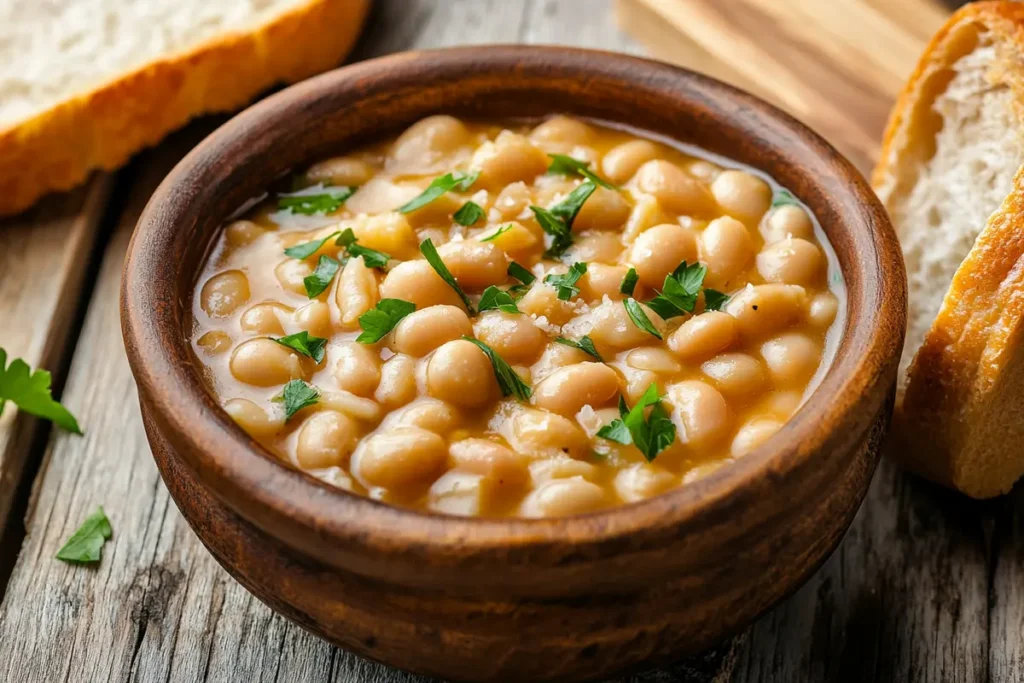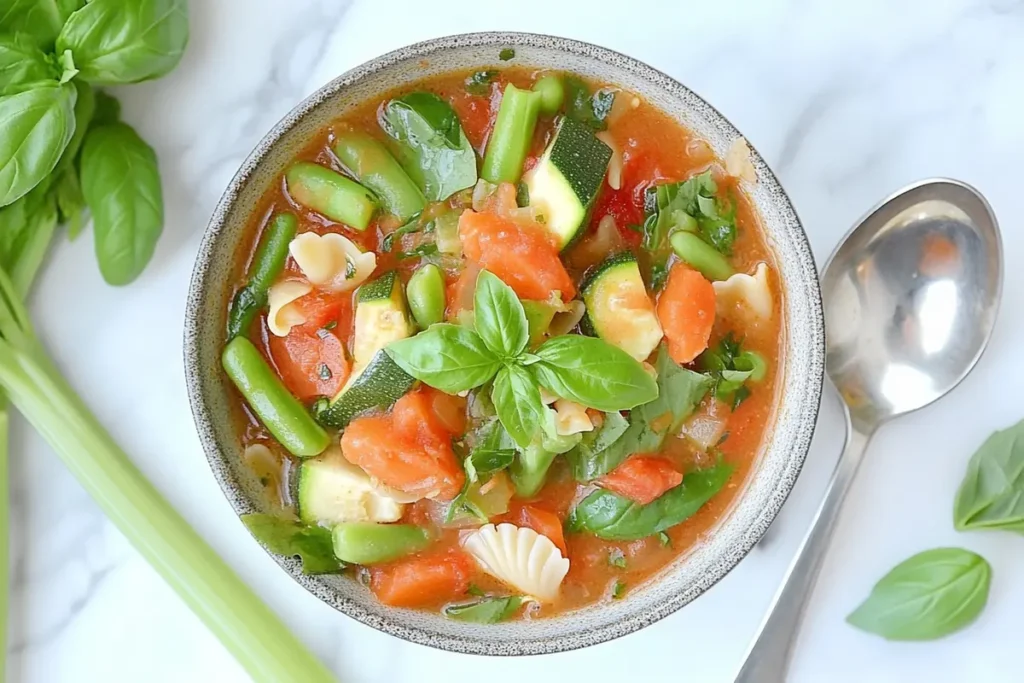Italian cuisine is renowned for its comforting and hearty dishes, with pasta fagioli and minestrone standing out as two iconic soups that have captured the hearts of food lovers around the world. But have you ever wondered, “Is pasta fagioli the same as minestrone?” While both are classic Italian soups, they have distinct ingredients, preparation methods, and cultural significance. Let’s explore their differences and similarities in this comprehensive guide.
What is Pasta Fagioli?

Origins and History of Pasta Fagioli
Italian-American communities often call pasta fagioli “pasta fazool,” and it means “pasta and beans” in English. This humble dish originated as a peasant meal in Southern Italy, where cooks transformed simple, inexpensive ingredients into flavorful, satisfying meals. Over time, Italian households embraced it as a staple and celebrated its affordability and versatility.
Key Ingredients in Pasta Fagioli
The defining components of pasta fagioli include:
- Beans: Typically cannellini or borlotti beans, providing a creamy texture and rich flavor.
- Pasta: Small pasta shapes like ditalini, elbow macaroni, or shells are commonly used.
- Broth: A combination of vegetable or chicken stock creates a flavorful base.
- Tomatoes: Crushed or diced tomatoes are often included, though some recipes are tomato-free.
- Herbs and Spices: Garlic, rosemary, thyme, and parsley are commonly used for seasoning.
How Pasta Fagioli is Made
Pasta fagioli is typically prepared by simmering beans and broth with aromatics like garlic, onions, and herbs. The pasta is cooked separately or added toward the end of cooking to prevent it from becoming too soft. This results in a hearty, rustic dish that can be adjusted to suit individual preferences.
What is Minestrone?

Origins and History of Minestrone
Minestrone has a longer and more complex history, dating back to ancient Rome. Cooks initially prepared this soup using whatever vegetables were available, creating a highly adaptable dish that reflects the region and season. Over centuries, Italians incorporated new ingredients like potatoes and tomatoes into this dish after explorers introduced them from the Americas.
Key Ingredients in Minestrone
Minestrone is a medley of vegetables, beans, and pasta or rice. Common ingredients include:
- Vegetables: Zucchini, carrots, celery, potatoes, and green beans are popular choices.
- Beans: Cannellini beans or kidney beans add protein and texture.
- Pasta or Rice: Small pasta shapes or rice are used as a starch component.
- Tomatoes: Provide a tangy base, though some versions are tomato-free.
- Broth: Vegetable or chicken stock serves as the liquid base.
- Herbs and Spices: Basil, oregano, and parsley enhance the flavor.
How Minestrone is Made
Minestrone is prepared by sautéing vegetables in olive oil, then simmering them with beans, tomatoes, and stock. Pasta or rice is added toward the end of cooking. The result is a thick, stew-like soup that showcases the flavors of fresh produce and hearty beans.
Is Pasta Fagioli the Same as Minestrone?
Although they share similarities, pasta fagioli and minestrone are distinct dishes. Here’s a closer look at their differences:
1. Ingredients
While both soups feature beans, pasta, and a broth base, minestrone is more vegetable-centric, often containing a wide variety of seasonal produce. Pasta fagioli focuses on the combination of beans and pasta, with vegetables playing a secondary role.
2. Consistency
Pasta fagioli is generally thicker and creamier due to the starch released by the beans and pasta. Minestrone, on the other hand, tends to be brothier, with a soup-like consistency that highlights the individual vegetables.
3. Flavor Profile
Pasta fagioli has a rich, earthy flavor dominated by beans and garlic, while minestrone is more vibrant and herbaceous, thanks to the variety of vegetables and herbs used.
4. Preparation
The preparation of pasta fagioli is simpler, focusing on fewer ingredients. Minestrone involves more chopping and a longer cooking time to allow the flavors of the vegetables to meld together.
Cultural Significance
Pasta Fagioli: A Dish of the People
Pasta fagioli has long been associated with Italy’s peasant roots. It’s a dish that exemplifies the idea of “cucina povera” (poor kitchen), turning basic ingredients into something extraordinary. It’s a comfort food for many Italians, evoking memories of family dinners and simple living.
Minestrone: A Celebration of Seasonality
Minestrone reflects Italy’s agricultural abundance, showcasing the freshest vegetables of the season. It’s a dish that celebrates regional diversity, with each area of Italy putting its own spin on the recipe.
Similarities Between Pasta Fagioli and Minestrone
Despite their differences, pasta fagioli and minestrone share several commonalities:
- Both are hearty and nutritious, making them ideal for a satisfying meal.
- They are versatile, allowing for substitutions and adaptations based on available ingredients.
- Both soups are rooted in Italian tradition, reflecting the country’s culinary ingenuity and appreciation for fresh, wholesome ingredients.
When to Choose Pasta Fagioli vs. Minestrone
Pasta Fagioli: Best for Comfort Food Cravings
If you’re in the mood for something creamy and comforting, pasta fagioli is the way to go. Its rich, bean-forward flavor is perfect for cozy nights.
Minestrone: Best for a Light and Fresh Meal
For a lighter, vegetable-packed option, minestrone is ideal. Its vibrant flavors and brothier texture make it a great choice for spring or summer.
Nutritional Comparison
Pasta Fagioli
- Calories: Approximately 300-400 per serving
- Protein: High due to beans and pasta
- Fiber: Excellent source from beans
- Carbs: Moderate, depending on pasta quantity
- Fats: Low, unless heavy olive oil is used
Minestrone
- Calories: Approximately 200-300 per serving
- Protein: Moderate from beans and vegetables
- Fiber: High due to a variety of vegetables
- Carbs: Varies based on pasta or rice addition
- Fats: Minimal, with most coming from olive oil
Tips for Making the Perfect Pasta Fagioli
- Use Dried Beans: For an authentic flavor and texture, cook your beans from scratch.
- Cook Pasta Separately: Add pasta to the soup just before serving to prevent it from soaking up too much broth.
- Season Well: A generous amount of garlic, herbs, and a splash of vinegar or lemon juice can elevate the flavors.
Tips for Making the Perfect Minestrone
- Use Seasonal Vegetables: Incorporate the freshest produce available for the best flavor.
- Layer Your Ingredients: Add vegetables in stages to ensure even cooking.
- Don’t Skip the Parmesan: Simmering a Parmesan rind in the soup enhances its depth of flavor.
Frequently Asked Questions
1. Can I make pasta fagioli without beans?
While beans are a key component, you can substitute lentils or chickpeas for a different twist.
2. Is minestrone always vegetarian?
No, but it’s often made vegetarian. Some versions include pancetta or a meat-based broth.
3. Can I freeze these soups?
Both pasta fagioli and minestrone freeze well, though it’s best to cook the pasta separately and add it after reheating.
4. What wine pairs well with these soups?
- Pasta Fagioli: A light red like Chianti.
- Minestrone: A crisp white like Sauvignon Blanc.
5. Are these soups gluten-free?
They can be made gluten-free by using gluten-free pasta or rice and ensuring all other ingredients are certified gluten-free.
Conclusion
So, is pasta fagioli the same as minestrone? While they share some similarities, their ingredients, flavors, and cultural roots distinctly set these two soups apart. Pasta fagioli offers creamy, bean-forward comfort, while minestrone showcases the vibrant diversity of seasonal vegetables. Whether you prefer one over the other or love both, these Italian classics are sure to warm your soul and satisfy your taste buds.